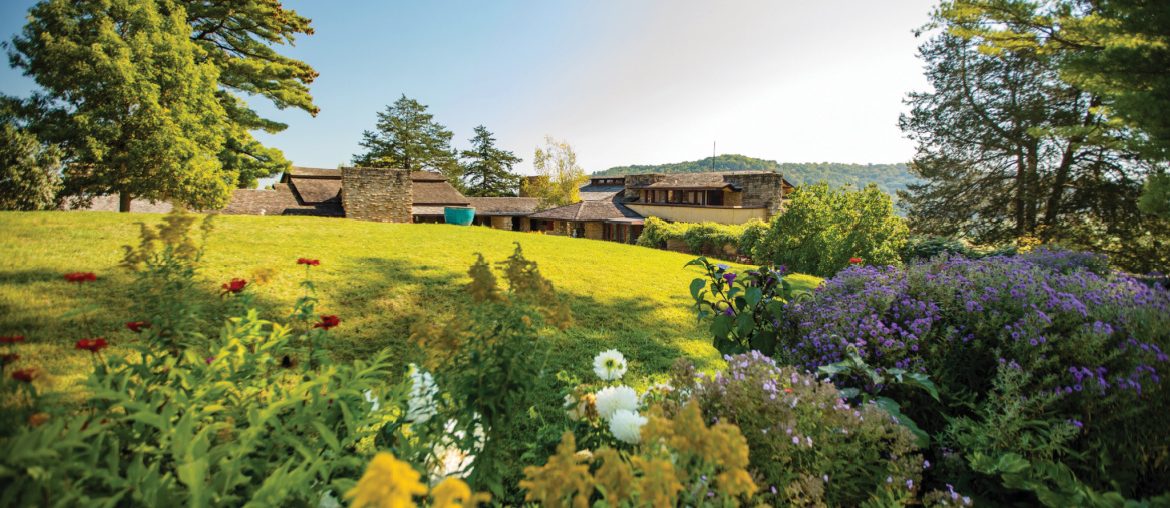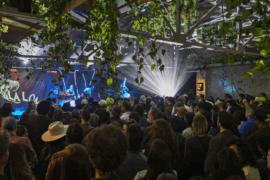By Shelby Deering | Photo courtesy Travel Wisconsin
It’s fair to say that Frank Lloyd Wright is one of the most famous architects who ever lived, and in Wisconsin we can count ourselves lucky to see his designs all over the state. Born in 1867 and living to the ripe old age of 91, he designed over 1,000 structures in his lifetime, located from Arizona to Pennsylvania and even Japan.
In Wisconsin alone, he designed and built 60 structures, 43 of which are still standing today. Born in Richland Center, he spent portions of his childhood in Iowa, Rhode Island and Massachusetts, but his family eventually moved back to Wisconsin. He always felt rooted here, even when he was living in Chicago or traveling the globe.
In a piece Wright wrote in 1932 for Wisconsin magazine, he sang the praises of his home state, saying, “Wisconsin soil has put sap into my veins. Why, I should love her as I loved my mother, my old grandmother, and as I love my work.”
You can follow in the footsteps of Wright by visiting his old haunts around the state, spots that were near and dear to his heart.
THE UNIVERSITY OF WISCONSIN-MADISON
Although Wright’s time at UW-Madison was brief — he started in 1886 and left the next year (without completing a degree) to pursue his career as an up-and-coming architect — the school still counts him as a noteworthy student. In that time, he joined UW’s first fraternity established in 1857 — Phi Delta Theta. During your campus visit, stop by the storied Bascom and North halls where Wright studied civil engineering.
For more FLW: Take a drive by the Wright-designed Eugene Gilmore House (120 Ely Pl.) that overlooks the UW-Madison campus and Lake Mendota. It’s nicknamed “the Airplane House” because of its distinctive, plane-like shape.
SPRING GREEN & ALDEBARAN FARM
Some of Wright’s best childhood memories were spent living and working at his uncle’s farm outside of Spring Green. Built in 1861, it’s where Wright first developed his deep appreciation for nature. Nowadays, the longstanding Aldebaran Farm is an Airbnb, where you’ll take in the same view that Wright did back in the day. The well-appointed interiors reflect Wright’s trademark style and is even 100% solar-powered.
For more FLW: During your stay, linger over the stunning view of Jones Valley that Wright loved, and spot Wright designs at Taliesin, his main homestead, like the Midway Barns and the Romeo and Juliet Windmill. Take the full four-hour estate tour to see Taliesin in all its glory, including designs connected to his family, such as the Tan-y-Deri residence that he designed for his sister and Hillside, the school he designed for his aunts.
MADISON & LOCATION OF CHILDHOOD HOME
Wright’s fingerprints can be seen all over Madison, and that makes sense, since one of his childhood homes was in the capital city. The family’s home, located at 802 E. Gorham St., was demolished to make way for Mayor Adolph H. Kayser’s stately brick estate in 1902. Today, you can still view the building (which is now home to Yahara House, a mental health center) and the property where Wright spent his childhood days.
For more FLW: You’d be remiss to not view Wright’s posthumously built Monona Terrace while in town. Walk up to the rooftop and take in lakeside views and admire Wright’s clean-lined architecture. (Currently, the interior is only open for private events, but check back for when they offer guided tours again.) Other Madison designs include the Robert Lamp House (22 N. Butler St.) and the First Unitarian Society Meeting House (900 University Bay Dr.).
RICHLAND CENTER & POSSIBLE BIRTHPLACE
Head toward Richland Center, in western Wisconsin, to see Richland Center to see where Wright first came into the world. Historians aren’t exactly sure of the house where he was born, though. There have been seven homes that are thought to be possible birthplaces, and a couple are still standing today. They include The Weigley House (on the corner of Church Street and Second Street) and The Wertz House (moved to the 700 block of South Park Street), both located downtown.
For more FLW: See the Frank Lloyd Wright-designed A.D. German Warehouse, located at 300 S. Church St. Designed in 1915, you can’t miss his trademark geometric details gracing the bricks lining the roof.






Comments are closed.